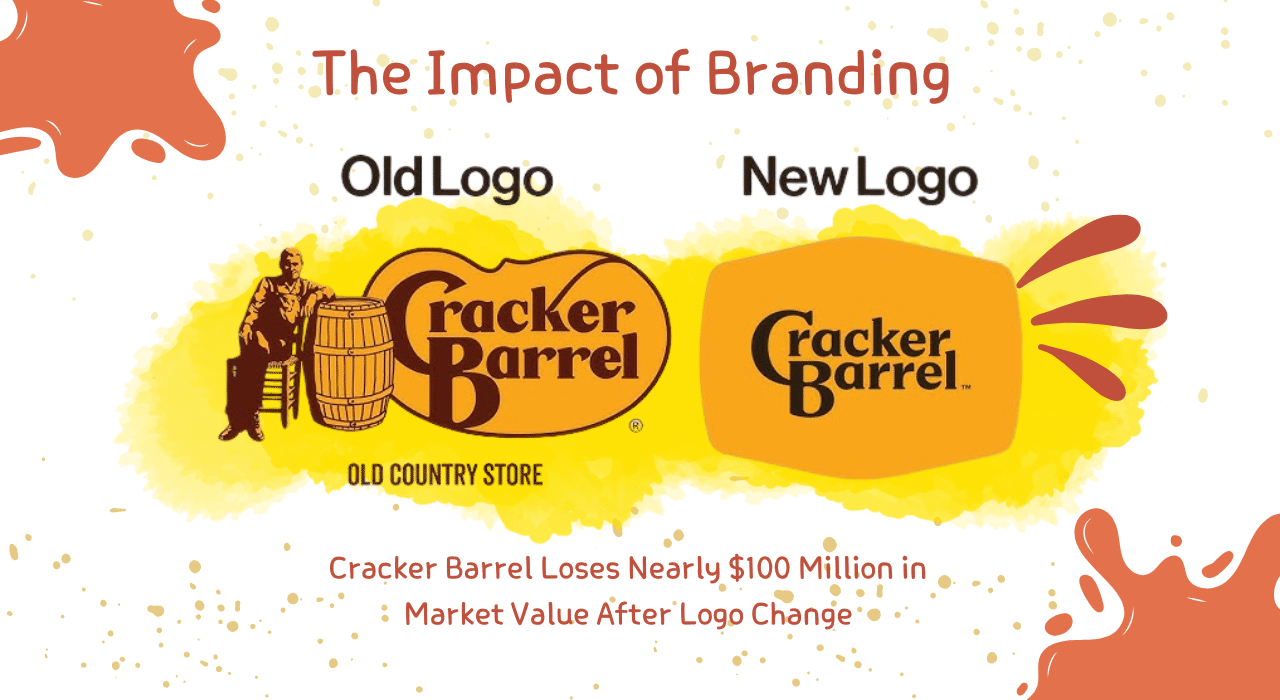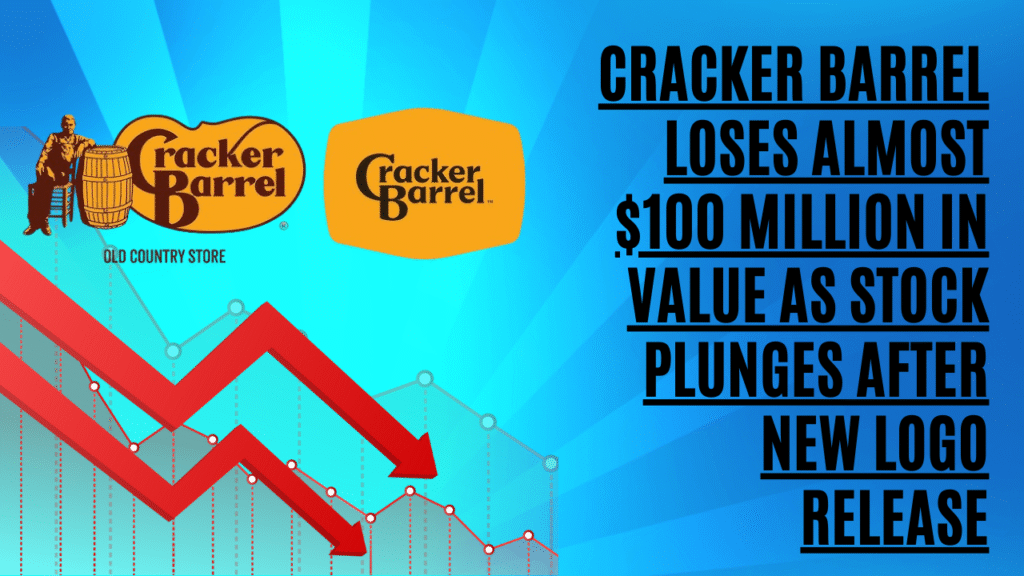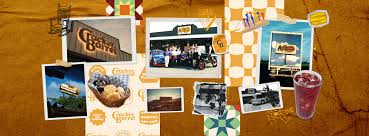The Impact of Branding: Cracker Barrel Loses Nearly $100 Million in Market Value After Logo Change

Table of Contents
- Introduction
- Cracker Barrel Loses: A Case Study in Brand Value
- The Power of Branding – Lessons From History
- Inside the Cracker Barrel Rebrand
- Branding Impact: What the Data Says
- Actionable Lessons for Companies
- Frequently Asked Questions (FAQ)
- Conclusion
1. Introduction
Branding holds the power to build empires or break them in a single moment. The phrase “Cracker Barrel Loses” has dominated recent headlines, highlighting a dramatic illustration of this truth. In August 2025, the beloved Southern hospitality restaurant chain, Cracker Barrel, experienced a sudden plunge in its stock price—destroying nearly $100 million in market value overnight—after unveiling a new logo and rebrand designed to modernize its image. This striking episode reveals vital lessons for marketers, business leaders, and investors who still underestimate the profound financial impact of brand identity in the digital age.
2. Cracker Barrel Loses: A Case Study in Brand Value
What Happened?
On August 21, 2025, Cracker Barrel released a new, simplified logo as part of a much larger brand makeover. The original, much-loved logo—featuring a genial man in overalls leaning on a barrel—was stripped away, replaced with a modern, text-only design on a distinctive gold background. Instead of anticipated applause, the retailer faced an avalanche of backlash from both loyal customers and investors. The company’s value dropped by nearly $100 million within one trading session, as the shares fell more than 12%.
Key Details:
- Old Logo: Seated man by a barrel—iconic Americana, nostalgia, and warmth.
- New Logo: Minimalist “Cracker Barrel” text, barrel illustration eliminated, gold palette representing “scrambled eggs and buttermilk biscuits.”
- Intended Message: Modernization, digital-friendliness, youthful appeal.
- Public Reaction: Backlash from nostalgic customers, online outrage (especially among conservative groups), and investor disappointment.
3. The Power of Branding – Lessons From History
3.1 Famous Branding Failures
Brand disasters are not unique to Cracker Barrel, and previous high-profile blunders highlight how easily companies can alienate fans—and crash their share price:
- New Coke (Coca-Cola, 1985): A “modernised” recipe replaced the classic, triggering a nationwide consumer revolt. Coca-Cola reverted to the original, but only after damage to both sales and brand trust.
- Tropicana (2009): The juice giant changed its orange-and-straw package to a minimalist design; consumers didn’t recognise it, leading to a 20% sales drop and a $30 million loss in just two months.
- GAP (2010): The new logo, meant to signal modernity, instead alienated loyal customers so deeply that GAP reversed course within a week.
- Bud Light (2023): A “woke” marketing push sparked a national boycott and led to a sales collapse, resulting in AB InBev experiencing a double-digit percentage loss in stock value.
Common Themes in Failed Rebrands:
- Ignoring core audience sentiment
- Overconfidence in the need for change
- Dilution of brand heritage and uniqueness
3.2 Logo Changes and Customer Loyalty
The visual elements of a brand—especially the logo—carry deep psychological and emotional meaning for customers. Changing a logo, if not done carefully and with audience buy-in, risks undermining brand equity, recall, and loyalty.
- Perceived authenticity and nostalgia drive consumer attachment.
- Changes that break with “heritage” can trigger emotional loss—and backlash.
- Positive transitions stem from clear communication, gradual evolution, and honouring tradition alongside innovation.
4. Inside the Cracker Barrel Rebrand
4.1 Why Did Cracker Barrel Change Its Logo?
Cracker Barrel CEO Julie Felss Masino described the logo update as part of a “strategic transformation” intended to refresh the 55-year-old brand for a new generation. Key reasons included:
- Struggling post-pandemic recovery, especially among its ageing, core customer base.
- Attracting younger customers seeking a “modern” but still comforting experience.
- The previous logo’s limitations in digital environments and signage.
- Corporate desire for broader cultural relevance and operational flexibility.
Quote:
“We’re just not as relevant as we once were. We need to transform to win over today’s guests, without losing our soul.”
— Julie Felss Masino, CEO
4.2 The Transformation Plan
Cracker Barrel’s makeover extended well beyond the logo:
- $700 million investment over three years
- Modernizing restaurant interiors (lighter colors, simplified décor, new furniture)
- Updated menus and more contemporary recipes
- New loyalty programs and tech enhancements
- Expansion of community events and collaborative marketing
4.3 Customer and Investor Reaction
Reaction was overwhelmingly negative among a vocal segment of fans and shareholders:
- Stock impact: Up to 15% dip on announcement, with nearly $100 million in value wiped in hours.
- Public outcry: Social platforms lit up with criticisms, particularly around abandonment of tradition, and accusations that the rebrand was “woke” or politically motivated.
- Main objections: Loss of nostalgia, perceived attack on Americana, and confusion over what the new brand stands for.
4.4 Financial Fallout: The Market Value Plunge
[Stock market graph showing corporate market value decline after rebranding decision.]

By the Numbers:
- Immediate drop: Shares opened at $54.80, down $4.22 (7.2%)—and fell as much as 15% intraday.
- Estimated loss: $94–$200 million in market value at the low point.
- Trading volume: Nearly quadruple the average, signalling panic and broad investor concern.
4.5 Social Media, Politics, and Corporate Identity
In the modern world, branding is instantly and sometimes ruthlessly judged online. Cracker Barrel’s changes were quickly dubbed “woke” by some conservative influencers and compared to the Bud Light fiasco of 2023. Critics argued that the company had “scrapped a beloved American aesthetic” for an abstract, bland identity, even as the company insisted its core values remained unchanged.
Political undertones:
- Outcry amplified by prominent conservative voices, including Donald Trump Jr.
- Social media posts with millions of views expressing frustration over the loss of “country hospitality.”
Corporate response:
- Cracker Barrel leaders emphasised they are “not abandoning tradition,” but rather evolving to stay relevant and accessible without sacrificing values.
5. Branding Impact: What the Data Says
5.1 How Branding Moves Stock Prices
Brand equity is not just a marketing buzzword—it represents a significant component of corporate value:
- Research consistently shows that strong brands deliver more stable revenues, higher profit margins, and—in times of crisis—stock price resilience.
- Negative events like poorly received advertising, controversial rebranding, or product recalls can have outsized immediate and long-term financial consequences.
Case Studies Table:
| Brand | Rebranding Action | Outcome | Stock/Value Impact |
|---|---|---|---|
| Cracker Barrel | Dropped iconic logo | $94–$200M lost in a day, PR crisis | -12% in a session |
| Tropicana | Changed packaging | 20% drop in sales in 2 months | -$30M in lost sales |
| Bud Light | “Woke” ad campaign | Boycotts, major sales crash | -10 to -15% stock |
| GAP | Unpopular new logo | Customer revolt, reversal in week | N/A (short-term) |
5.2 Brand Loyalty, Nostalgia, and Risk
- Loyalty is fragile: Customers form emotional bonds with brand visuals, and changes risk severing that relationship.
- Nostalgia equals value: What might seem “outdated” to marketers can be a powerful source of differentiation and brand love to regulars.
- Risk of alienation: A brand refresh must balance new market needs with the core expectations of its devoted base.
5.3 Consumer Psychology and the Role of Logos
Research in visual marketing shows:
- Colourful, distinctive logos increase perceived brand variety and positive attitudes—especially for generalist brands.
- Logos that break with established visual memory, however, can cause consumer confusion and negative sentiment.
- Brand recognition powers trust and drives higher purchase intent.
6. Actionable Lessons for Companies

- Respect Nostalgia: Changing iconic elements comes at real risk; always take time to listen to your loyalists.
- Test and Listen: Use focus groups and digital surveys to pre-test potential changes, gathering honest feedback.
- Gradual Evolution: If a refresh is needed, slowly modernize while communicating the reasons and honoring heritage.
- Crisis Communication: Be ready with open, authentic messaging to address backlash directly and explain your reasoning.
- Monitor Metrics: Track sentiment, sales, and stock impact in real time to adjust marketing and PR strategies as needed.
- Balance Old and New: Successful rebrands acknowledge tradition while positioning for the future—never abandoning either.
Related Internal Service Pages:
Authoritative External Sources:
- Forbes: Why Rebranding Is More Relevant Than Ever in 2025
- Harvard Business Review: Why Strong Brands Survive Crises
- CNBC: Cracker Barrel shares plummet after pushback on new logo, brand refresh
7. Frequently Asked Questions (FAQ)
Q1: Why did Cracker Barrel lose so much value after changing its logo?
A1: Cracker Barrel loses value due to a combination of customer backlash, investor disappointment, and viral social media criticism over abandoning its classic logo, which many saw as central to its American identity. This drove large-scale stock selloffs and a rapid drop in market capitalisation.
Q2: Has a logo change ever improved a company’s fortunes?
A2: Yes, when done with proper research and incremental updates, logo changes can rejuvenate a brand, attract new customers, and align with digital trends. Gradual evolution tied to clear communication is key; its success depends on respecting loyal customers’ attachment to historic visual identities.
Q3: How important is brand recognition in today’s digital marketplace?
A3: In a crowded online marketplace, a recognizable brand builds instant trust, reduces marketing costs, and drives higher conversion rates. When a company like Cracker Barrel loses visual identity, it risks eroding that trust, especially among its core base.
Q4: What should companies do before launching a rebranding?
A4: Use real-world customer feedback, pilot launches, and phased rollouts to understand and mitigate risk. Communicate transparently the reasons for change, and celebrate legacy elements as part of the new identity-building process.
Q5: Was politics involved in the Cracker Barrel logo controversy?
A5: Yes. The reaction included strong criticism from conservative commentators and political influencers, who accused the company of being “woke” and abandoning its traditions for the sake of inclusivity or modernisation. Such polarised discourse can further amplify the negative market impact.
Q6: Did Cracker Barrel’s new logo affect restaurant traffic?
A6: Data is mixed in the short term; while the market value dropped sharply, the company reports ongoing trials with new designs. Future customer visitation trends will be monitored as the new brand identity takes hold.
Q7: Can other brands avoid a “Cracker Barrel Loses” scenario?
A7: Yes. Companies must balance modernization with heritage, involve all stakeholders, and frame changes as an evolution—not a break—from their roots. Proactive listening and clear explanation make all the difference.
8. Conclusion
The Cracker Barrel case is a powerful reminder: brand identity is more than design—it is trust, nostalgia, and community. When the equation changes too rapidly, brands risk not just public backlash but immediate, measurable financial losses. Savvy companies recognize that their logos and stories are deeply intertwined with both their balance sheets and the emotional expectations of their audience. Learning from “Cracker Barrel Loses,” the real win is in finding the sweet spot between innovation and tradition.












